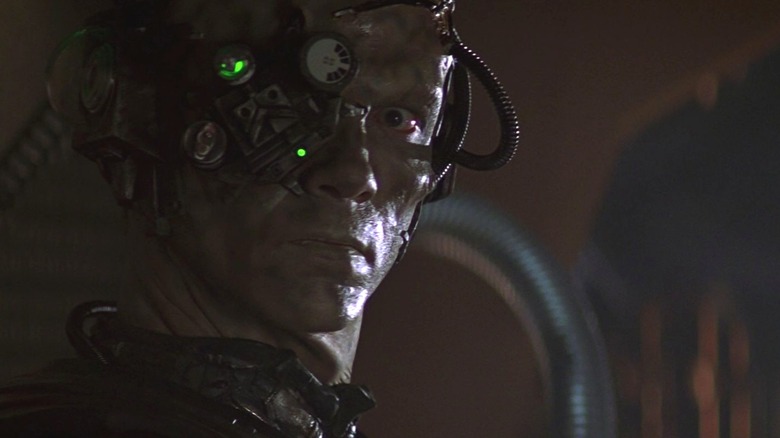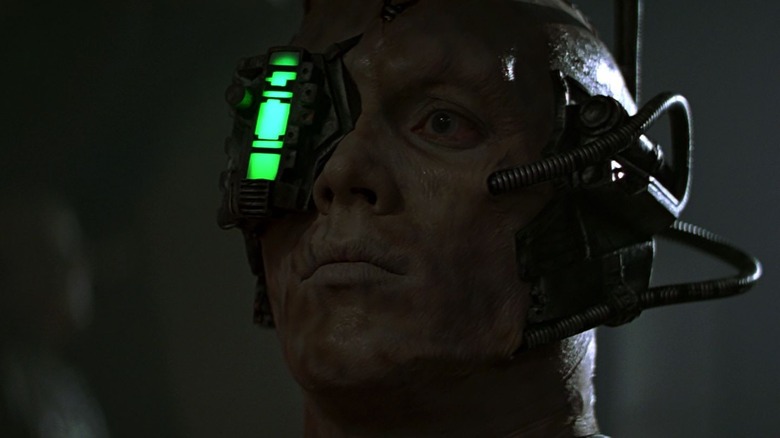The Borg Heads In Star Trek: First Contact Contain Hidden Messages
If I may start with a personal, somewhat braggadocious anecdote, I personally visited the sets of "Star Trek: The Next Generation" and "Star Trek: Deep Space Nine" back in 1993, when I was still in high school, and my "Star Trek" fandom was riding at its most intense. I was instructed to touch nothing, and I didn't — I also wasn't allowed to sit in Captain Picard's chair, which was a bummer — but I was permitted to look as closely at the computer panels and walls as I wanted.
Close inspection revealed a raft of teeny-tiny in-jokes that would never appear on camera, clearly designed by crew members and set designers to keep themselves amused while assembling the series. One might know that the wall panels of the U.S.S. Enterprise-D sport small, brown oval shapes indicating what might be behind that panel. In reality, those ovals contain little gags that read "Never tug on Superman's cape," or "Don't spit in the wind." Additionally, the computer panel layout on the Enterprise-D — called LCARS — featured five-letter notations on each button. The letters are the initials of crew members who designed the series.
The set of "Deep Space Nine" contained even more hidden text on its walls, and there were too many gags to get in here. But "Deep Space Nine" made it clear that set designers members knew they could be playful with tiny in-jokes they knew would never be picked up by a camera lens.
This impishness carried over to production of "Star Trek: First Contact" in 1996, when special makeup effects artist Jacob Garber found that he could hide in-jokes in the film's Borg makeup. Garber finally revealed his little pranks in a 2016 oral history of "First Contact" printed in the Hollywood Reporter.
The jokes in the Borg heads
"Star Trek: First Contact" involves the Borg, a soulless species of all-consuming cyborgs that share a single consciousness. The Borg truck around the galaxy in cube-shaped ships and absorb anything they can into their collective, stealing technology they need, and assimilating individuals to work as mindless drones. When someone is assimilated, the Borg implant their bodies with tubes and machines, sometimes even replacing their eyes and hands with useful gadgets. The actors who played Borg drones had to undergo lengthy makeup processes, having their faces covered with mechanical prosthetics and light-up appliances.
As one might imagine, the makeup process for "First Contact" took up the bulk of the day, with the makeup department having to stay open for double shifts. Garber recalls the lengthy workday, and how the monotony eventually got to him. After applying hundreds of Borg appliances, day in and day out for weeks, Garber started throwing in little in-jokes, inscribed directly onto the cranial machines. He said:
"We were the first ones there and the last ones gone. I don't recall anything less than a 14-hour day. I ended up sneaking in a bunch of hidden messages in the Borg headpieces. I think I got about every makeup artist's name in there somewhere. I snuck one in there that was 'Westmore's House of Barbecue,' I put me and a girl I was dating at the time in there."
Westmore is a reference to Michael Westmore, the head makeup artist for many "Star Trek" projects starting in 1987.
Garber and the rest of the "First Contact" team were nominated for an Academy Award for their work. Garber himself worked on high-profile shows like "The X-Files," "The Walking Dead," and "Fallout." He has been nominated for 10 Emmys, and won three.

